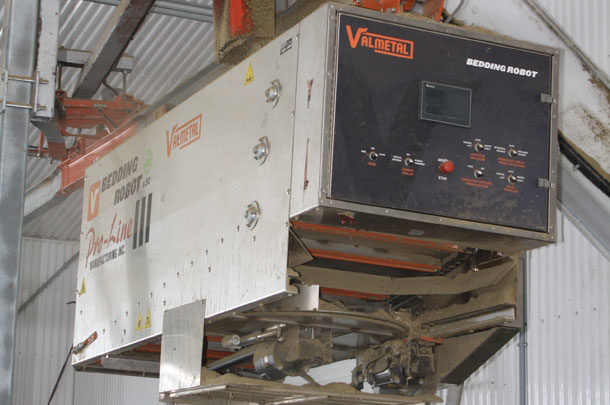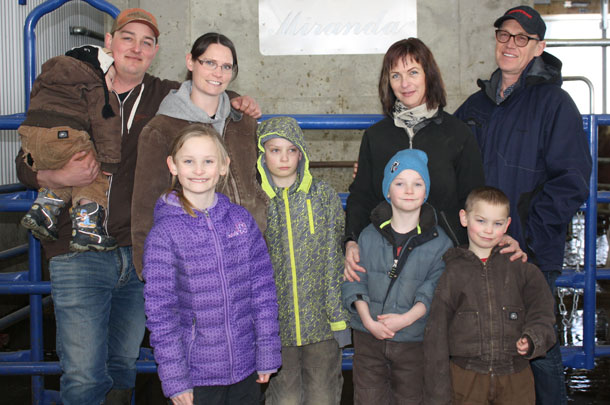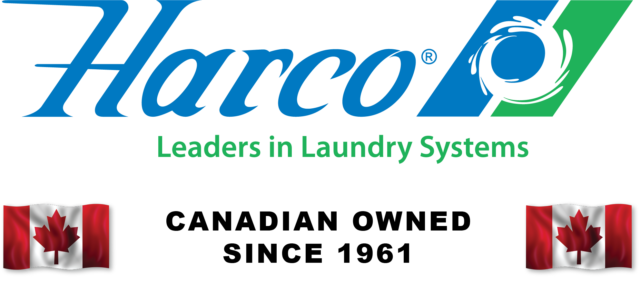Corenco Holsteins
Just west of Ponoka, three generations of the Roeland family are actively involved in Corenco Holsteins. Cor and Jacolien Roeland are joined by son Maarten and his wife, Charlene, along with their children, in the 160-cow dairy operation. A new barn was built in 2018, featuring three DeLaval VMS milking robots in a free-flow style. In addition to milking, bedding stalls is also an automated task, with a ValMetal robotic bedding delivery system installed last year.
The bedding robot’s metal box runs along a track, distributing chopped canola straw once per day to each bed in the barn. A conveyor system transports the straw from a commodity box outside of the barn into the robot box. Maarten Roeland sets the weight of straw to be delivered to each group throughout the barn, tweaking as necessary to achieve a consistent deep pack for optimum comfort. Stalls are maintained manually twice a day, helping Roeland to achieve his goal of minimal human disturbance in the pens.
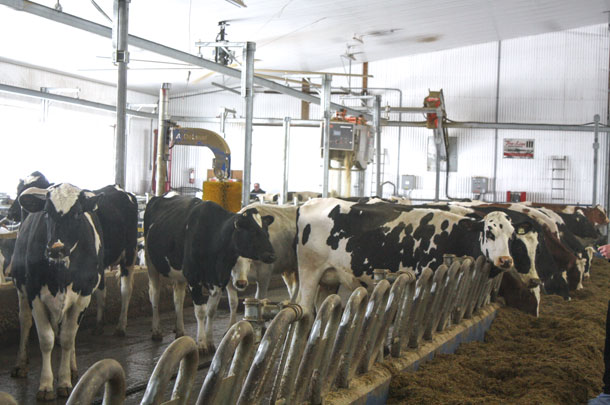
With cow comfort in mind, the barn displays some other unique features. The six-row design includes a main feed alley, along with an additional feed alley on the outside row to offer more bunk space. A wavy feed rail runs the length of the feed alleys. It provides the benefits of allowing cows to lift their heads while eating without any point of neck abrasion, while also serving as a divider at the bunk to prevent boss cows from pushing timid herdmates away. Similar to the feed rail, the Roelands also selected a curved neck rail design to promote natural rising behavior.
Air quality is another piece of the cow comfort puzzle at Corenco Holsteins. The ventilation system uses curtains to allow outside air in, which is mixed with the rising warm air inside the barn by large high-volume, low-speed (HVLS) fans. Chimney fans along the rooftop remove stale air.
See more photos of all three facilities in this slideshow.
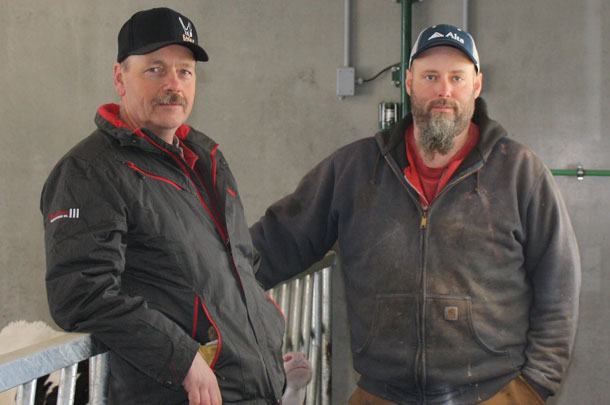
Janna Dairy Ltd.
In a newly built barn, John and Shanna Hulsman combine automated feeding with a climate-controlled environment that optimizes calf health and growth potential.
Adjoining the main milking parlour, precast concrete walls were added to create four all-in, all-out calf rooms. Here, calves spend the first nine to 12 weeks of their life, grouped with cohorts on a deep bed of straw. John Hulsman strives for newborns to be on the auto-feeders by day three and acclimates them by setting up a gated pen within the calf room. Each room has an auto-feeder, where calves consume a limit of 8 litres of milk replacer daily. Automated controls regulate a consistent humidity level and temperature, bringing in cold air from the outside and warming it to heat the room in the winter, or cooling air and venting it out in the summer months.
Hulsman has seen improved calf health since moving youngstock from an older converted dairy barn into the new facility. “Calves don’t have to move environments,” he said. “They are in the same room, with the same air and the same friends.” This reduces stress on the animals while promoting socialization and protection from climate volatility.
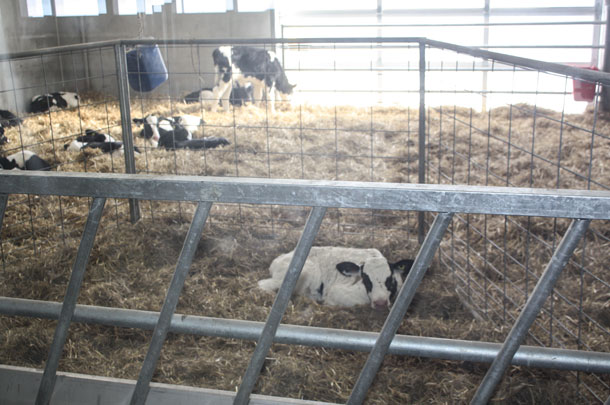
With respiratory disease well controlled, the biggest challenge Hulsman faces with group housing is scours. He contributes a stringent biosecurity protocol for staff and visitors with improving this challenge on the dairy. Further, he has found giving the auto-feeder nipples an extra outside cleaning daily, and replacing them regularly, helps with calf health.
The building also includes three bedded-pack pens for weaned calves. Windows along the concrete walls give way to natural light, and power curtains, chimneys and fans regulate the temperature on this side of the barn. The new facility is sized for future growth of the milking herd, but in the meantime, both heifer and bull calves from the 210-cow herd are raised together.
Looking ahead, Hulsman believes this facility is poised for worker comfort and the success of the next generation of family members and cattle at the dairy. “I’m not just trying to raise an animal, I’m trying to raise a cow,” he added.
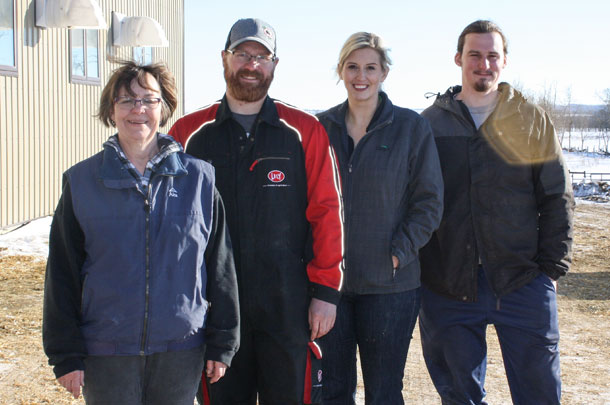
Crestomere Holsteins
Near Ponoka, the 104-cow herd at Crestomere Holsteins has settled into a new sand-bedded freestall barn with robotic milking, as well as automated feed mixing and delivery.
Prior to last October, the Simanton family milked their 85-cow herd in a tiestall barn, feeding a TMR and allowing pasture access during the milder months. Now, they rely on a Lely Vector to combine the lactating ration’s main forages of barley silage, corn silage and alfalfa. “Consistency is key,” Lee Simanton said. He and his wife, Lisa, operate the dairy with Lee’s parents, Everett and Marylee Simanton. They also employee a full-time Brazilian trainee on the dairy.
Located along the back wall of the barn, a conveyor system brings each ingredient from its dedicated bin up into the unit for mixing. The Vector then makes its lap around the outside feed alleys of the barn as often as 15 times each day. It delivers fresh feed while pushing up the pile and measuring bunk fill. Lee noticed a difference almost immediately. “We were up 200 litres of milk the first day we moved in,” he said.
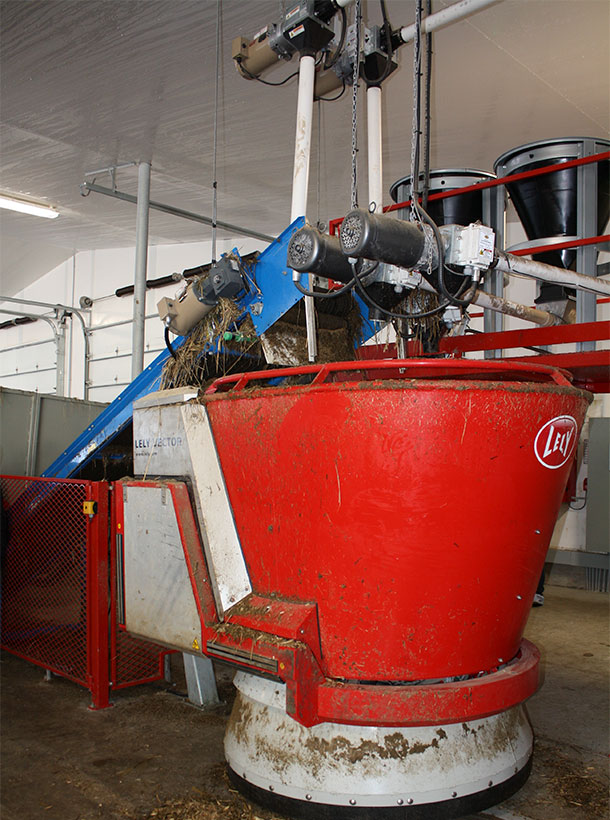
The cows have responded favorably to the sand bedding and other comfort features of the new barn as well. At the bunk, looped dividers index the cows along the feed rail, thus preventing boss cows from pushing others away from feed. This is particularly important because both first-calf heifers and mature cows are grouped together in the robot pens. For added comfort during eating, cows stand on a 2.5-inch raised concrete platform, lined with a half-inch of rubber. This design also prevents manure from collecting around the animals’ hooves while at the bunk.
Close-up, fresh cows and those requiring extra attention are kept on a bedded pack with shared robot access. All cows go through their first milking after calving in the automated milking system but are allowed to stay in the pack pen for three or four days before crossing over into one of the two milking group pens.
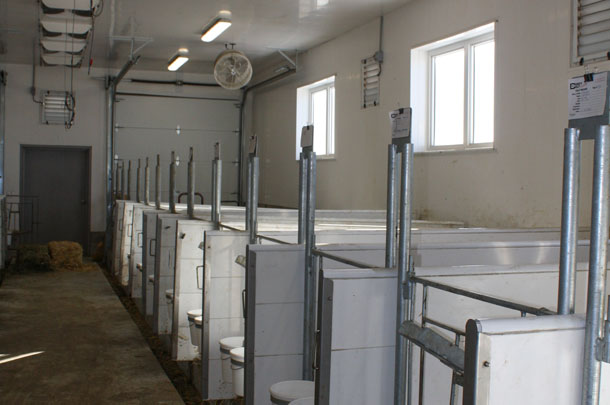
Connected to the milking barn is a calf room with individual pens and in-floor heating. An overhead door is opened and panels can be removed for easy skid steer cleaning.
The preconference tours were followed by the 37th annual Western Canadian Dairy Seminar, March 6-8, in Red Deer, Alberta. ![]()

-
Peggy Coffeen
- Editor
- Progressive Dairyman
- Email Peggy Coffeen
PHOTO 1: Corenco Holsteins: The bedding robot is filled from a conveyor and calibrated to deliver the appropriate amount of bedding in each stall.
PHOTO 2: Corenco Holsteins: Three generations of the Roeland family make up the Corenco Holsteins team, including Maarten and Charlene, their children Micalah, Riley, Levi, Colton and Remington, along with Maarten’s parents, Jacolien and Cor Roeland.
PHOTO 3: Corenco Holsteins: A bedding robot delivers chopped canola straw throughout the barn. Cow comfort features include a wavy feed rail at the bunk, as well as wavy neck rails in the stalls.
PHOTO 4: Janna Dairy: Owner John Hulsman (left) and his herd manager Lloyd Phillips (right).
PHOTO 5: Janna Dairy: Pre-weaned calves are kept in climate-controlled all-in, all-out pens. Newborns are introduced to the group and separated by gates for the first couple of days before joining their pen mates at the auto-feeder.
PHOTO 6: Crestomere Holsteins: Marylee Simanton, Lee and Lisa Simanton, and Brazilian trainee, Anderson. Not pictured: Everett Simanton.
PHOTO 7: Crestomere Holsteins: A conveyor system brings each feed ingredient into the Vector for mixing. Barley silage, corn silage and alfalfa make up the bulk of the lactating ration.
PHOTO 8: Crestomere Holsteins: The newly built barn includes a wing with individual calf pens. Panels are removed for easy cleaning by driving through the overhead door with a skid steer. Photos by Peggy Coffeen.
